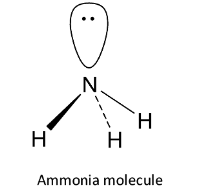Answer
35.1k+ views
Hint: Ammonia is a volatile trihydride of the element nitrogen of group 15. It has the formula \[{\text{N}}{{\text{H}}_{\text{3}}}\] . Nucleophiles or nucleophilic reagents are attracted to the nucleus or are nucleus loving or positive charge loving. Thus, the nucleophiles can be said to be the type of reagent species which are rich in electrons. Thus, the nucleophiles are negatively charged species.
Nucleophiles are of two types, negative nucleophiles or neutral nucleophiles. According to the Lewis concept, a nucleophile can donate an electron pair and hence it acts as a Lewis base.
Complete step by step answer:
The negative nucleophiles are those nucleophiles which have an excess electron pair and carry a negative charge. For example, carbanions have an unshared electron pair and a negative charge and hence they are negative nucleophiles. Another example of negative nucleophile is the bromide ion.
The neutral nucleophiles are those nucleophiles which have an unshared pair of electrons but do not carry any charge. Now, let us see the structure of the ammonia molecule. The valence shell configuration of nitrogen is ${\text{2}}{{\text{s}}^{\text{2}}}{\text{2}}{{\text{p}}^{\text{3}}}$ and it undergoes ${\text{s}}{{\text{p}}^{\text{3}}}$ hybridization. Three of the four ${\text{s}}{{\text{p}}^{\text{3}}}$ hybrid orbitals overlap with 1s orbitals of 3 hydrogen atoms to form 3 ${\text{N - H}}$ sigma bonds while the fourth contains the lone pair of electrons. It has pyramidal structure.

Thus ammonia contains a lone pair of electrons but has no charge. Hence, it is a neutral nucleophile. So, option A is correct.
An electron deficient molecule will try to take electrons from other sources and thus it is electron loving. Therefore, it will be an electrophile. So, option B is wrong.
A homolytic molecule undergoes homolytic fission to give free radicals. In homolytic bond fission, the shared pair of electrons is distributed equally between two bonded atoms. So, option C is wrong.
According to the Lewis concept, an electrophile accepts an electron pair and hence it acts as a Lewis acid and a nucleophile can donate an electron pair and hence it acts as a Lewis base. Thus ammonia is a base and not an acid.
So, option D is wrong.
Note: Another type of reagent is free radical. It is a neutral species carrying an unpaired electron and it is formed by the homolytic bond fission of a covalent bond. Due to the presence of unpaired electrons, free radicals are paramagnetic.

Nucleophiles are of two types, negative nucleophiles or neutral nucleophiles. According to the Lewis concept, a nucleophile can donate an electron pair and hence it acts as a Lewis base.
Complete step by step answer:
The negative nucleophiles are those nucleophiles which have an excess electron pair and carry a negative charge. For example, carbanions have an unshared electron pair and a negative charge and hence they are negative nucleophiles. Another example of negative nucleophile is the bromide ion.
The neutral nucleophiles are those nucleophiles which have an unshared pair of electrons but do not carry any charge. Now, let us see the structure of the ammonia molecule. The valence shell configuration of nitrogen is ${\text{2}}{{\text{s}}^{\text{2}}}{\text{2}}{{\text{p}}^{\text{3}}}$ and it undergoes ${\text{s}}{{\text{p}}^{\text{3}}}$ hybridization. Three of the four ${\text{s}}{{\text{p}}^{\text{3}}}$ hybrid orbitals overlap with 1s orbitals of 3 hydrogen atoms to form 3 ${\text{N - H}}$ sigma bonds while the fourth contains the lone pair of electrons. It has pyramidal structure.

Thus ammonia contains a lone pair of electrons but has no charge. Hence, it is a neutral nucleophile. So, option A is correct.
An electron deficient molecule will try to take electrons from other sources and thus it is electron loving. Therefore, it will be an electrophile. So, option B is wrong.
A homolytic molecule undergoes homolytic fission to give free radicals. In homolytic bond fission, the shared pair of electrons is distributed equally between two bonded atoms. So, option C is wrong.
According to the Lewis concept, an electrophile accepts an electron pair and hence it acts as a Lewis acid and a nucleophile can donate an electron pair and hence it acts as a Lewis base. Thus ammonia is a base and not an acid.
So, option D is wrong.
Note: Another type of reagent is free radical. It is a neutral species carrying an unpaired electron and it is formed by the homolytic bond fission of a covalent bond. Due to the presence of unpaired electrons, free radicals are paramagnetic.

Recently Updated Pages
To get a maximum current in an external resistance class 1 physics JEE_Main

If a wire of resistance R is stretched to double of class 12 physics JEE_Main

Let f be a twice differentiable such that fleft x rightfleft class 11 maths JEE_Main

Find the points of intersection of the tangents at class 11 maths JEE_Main

For the two circles x2+y216 and x2+y22y0 there isare class 11 maths JEE_Main

The path difference between two waves for constructive class 11 physics JEE_MAIN

Other Pages
when an object Is placed at a distance of 60 cm from class 12 physics JEE_Main

If a wire of resistance R is stretched to double of class 12 physics JEE_Main

Which of the following sets of displacements might class 11 physics JEE_Main

Oxidation state of S in H2S2O8 is A 6 B 7 C +8 D 0 class 12 chemistry JEE_Main

What is the pH of 001 M solution of HCl a 1 b 10 c class 11 chemistry JEE_Main

The correct IUPAC name of the given compound is A isopropylbenzene class 11 chemistry JEE_Main



